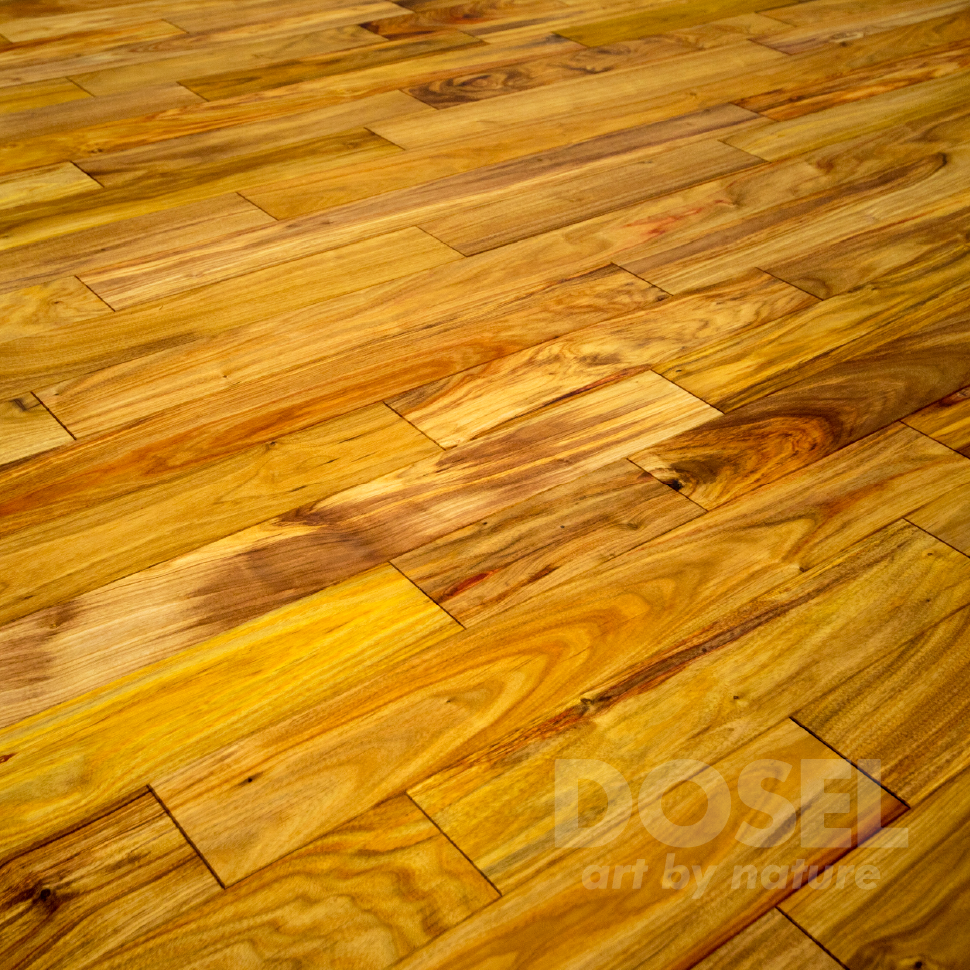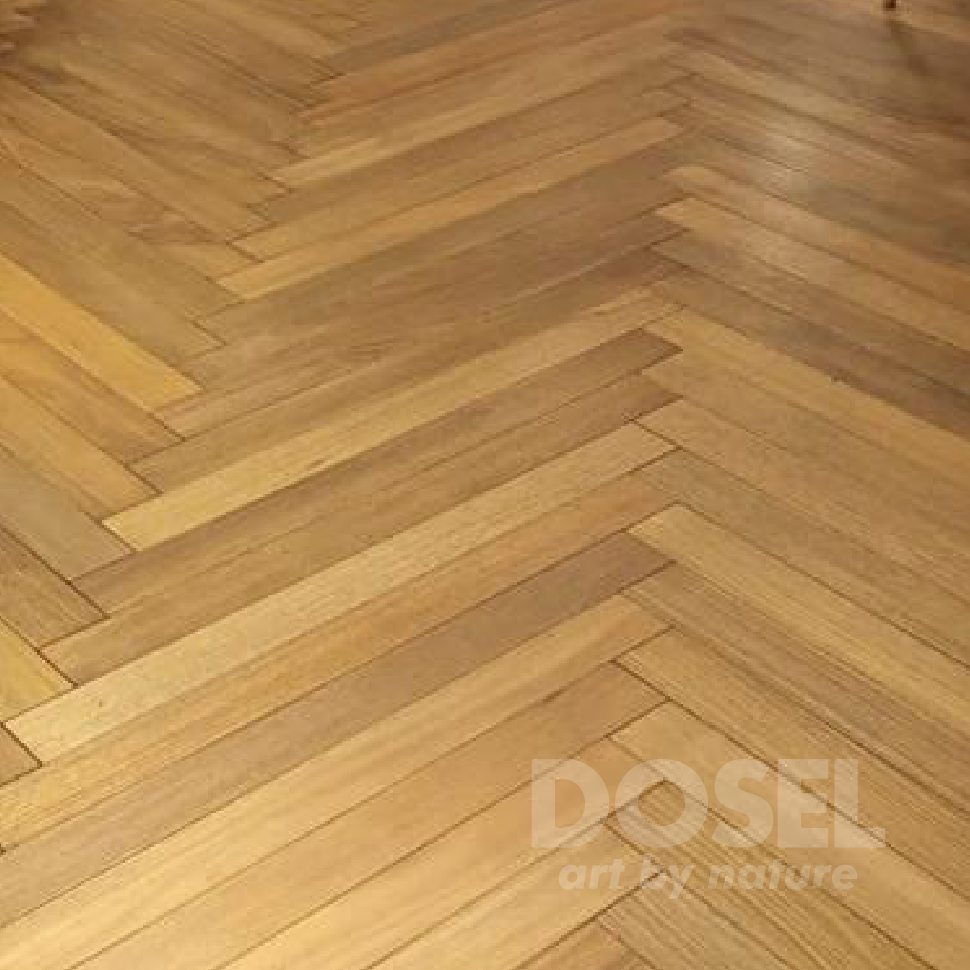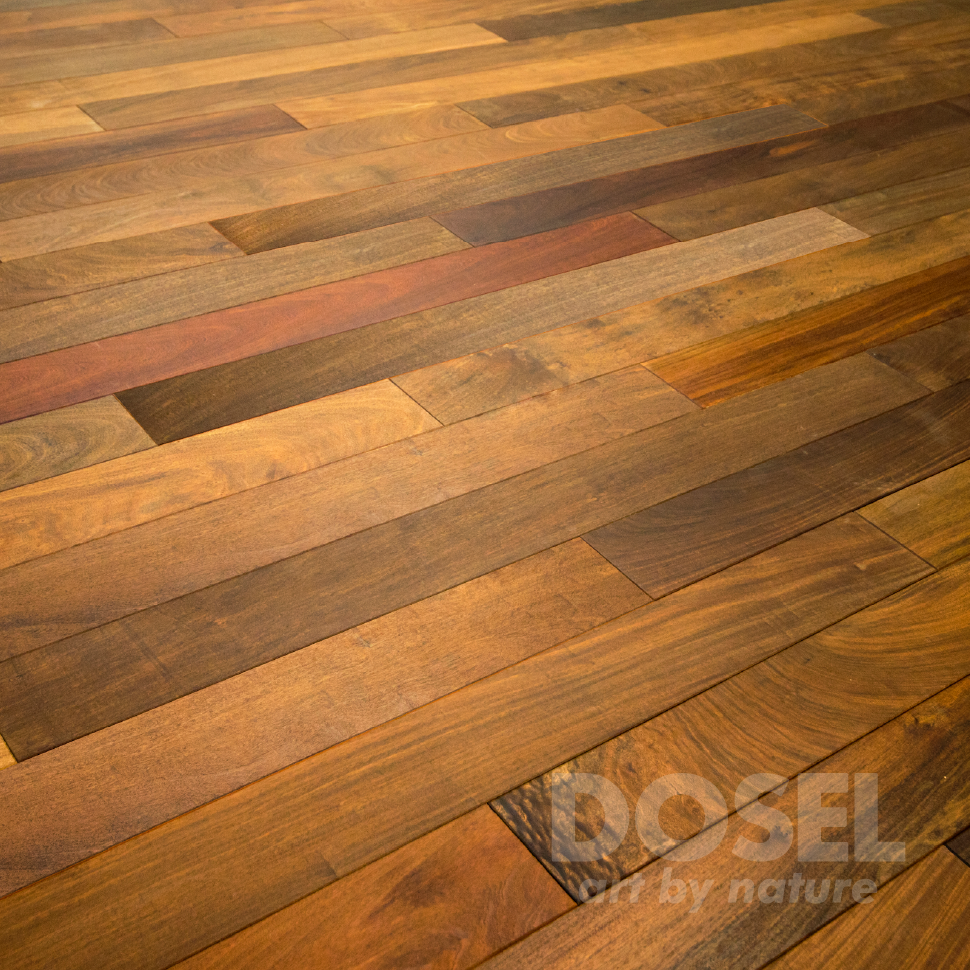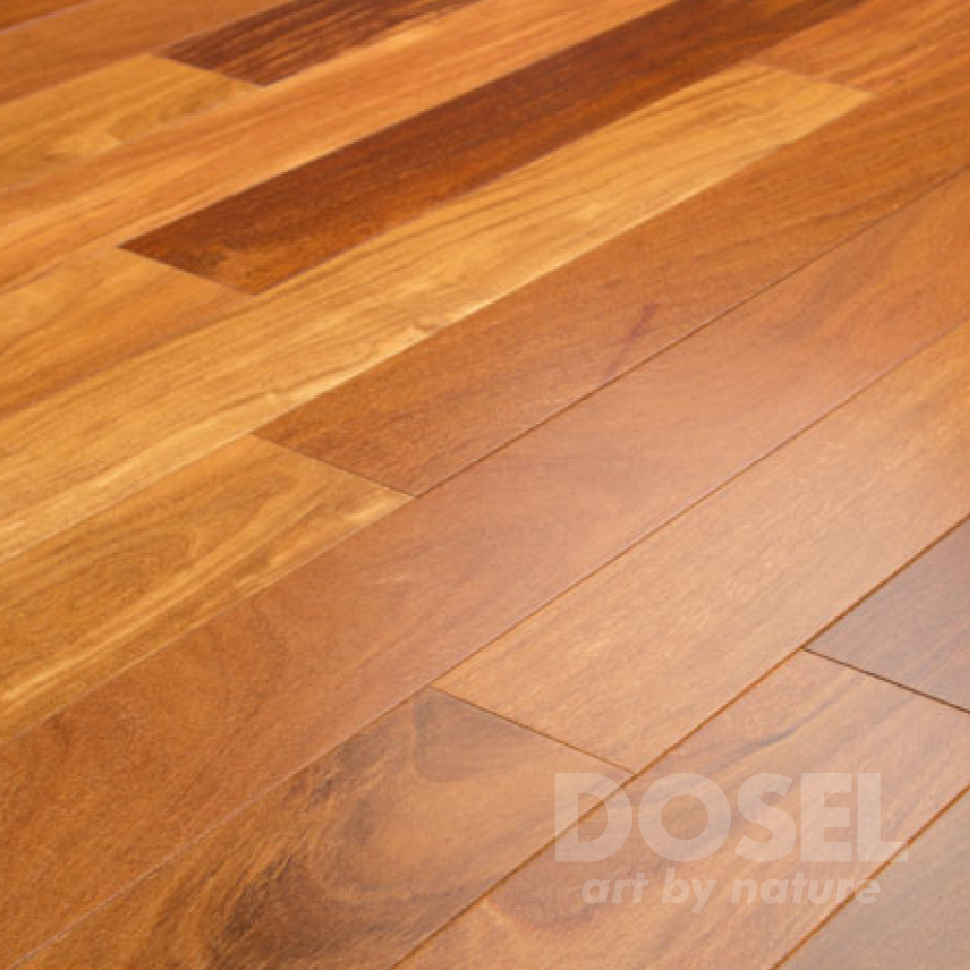
OUR SPECIES
1
OUR SPECIES
CANARY WOOD
(Centrolobium Sp)
Rated as moderately easy to work for Stair parts, furniture, canoes, turnery, tool handles and joinery.
Description: Canarywood , also known as Tarara Amarilla, is a strikingly beautiful hardwood flooring material that comes from the forests of Brazil and Bolivia. Its initial color is bright yellow and orange with accent streaks of red, brown, purple, and black. After exposure to sunlight and atmosphere, the vibrant colors mellow a bit, but the wood will still maintain its unique character and appearance. Canary hardwood flooring has a hardness rating of 1860, which is almost identical to Tigerwood.
Scientific Properties and Technical Specifications
| Common Name(s): | Canarywood, Canary |
| Scientific Name: | Centrolobium spp. |
| Distribution: | South America (from Panama down to southern Brazil) |
| Tree Size: | 65-100 ft (20-30 m) tall, 2-3 ft (.6-1.0 m) trunk diameter |
| Average Dried Weight: | 52 lbs/ft3 (830 kg/m3) |
| Specific Gravity (Basic, 12% MC): | .65, .83 |
| Modulus of Rupture: |
19,080 lbf/in2 (131.6 MPa) |
| Elastic Modulus: |
2,164,000 lbf/in2 (14.93 GPa) |
| Crushing Strength: | 9,750 lbf/in2 (67.2 MPa) |
| Shrinkage Radial: |
9,750 lbf/in2 (67.2 MPa) |
| Tangential: | 7.5% |
| Volumetric: | 11.4% |
| T/R Ratio: | 1.8 |
2
OUR SPECIES
Southern Teak
(Dipteryx odorata)
Rated as moderately easy to work for Decking, flooring, canoes, turnery, tool handles, railroad ties and joinery.
Desription: (commonly known as "Southern Teak", "kumaru", or "Brazilian teak") is a species of flowering treein the pea family, Fabaceae. The tree is native to Northern and Central South America and is semi-deciduous. Its seeds are known as tonka beans (sometimes tonkin beans or tonquin beans). They are black and wrinkled and have a smooth, brown interior. They have a strong fragrance similar to seet woodruff due to their high content of coumarin.
Scientific Properties and Technical Specifications
| Common Name(s): |
Southern Teak, Brazilian Teak, Almendro, Almendrillo |
| Scientific Name: |
Dipteryx odorata |
| Distribution: |
Northern South America |
| Tree Size: |
130-160 ft (40-50 m) tall, 3-5 ft (1-1.5 m) trunk diameter |
| Average Dried Weight: |
68 lbs/ft3 (1,085 kg/m3) |
| Specific Gravity (Basic, 12% MC): |
86, 1.09 |
| Janka Hardness: |
3,330 lbf (14,800 N) |
| Modulus of Rupture: |
25,390 lbf/in2 (175.1 MPa) |
| Elastic Modulus: |
3,237,000 lbf/in2 (22.33 GPa) |
| Crushing Strength: |
13,850 lbf/in2 (95.5 MPa) |
| Shrinkage Radial: |
5.3% |
| Tangential: | 7.7% |
| Volumetric: | 12.6% |
| T/R Ratio: | 1.5 |
3
OUR SPECIES
Tauari or Bitumbo
(Couratari guianensis)
Rated as moderately easy to work for flooring, furniture, turnery, tool handles, venner and joinery.
The fine leaf wadara, cachimbo caspi, cachimbo, capa de tabaco, coco cabuyo, or tauari, is a species of woody plant. It is found in Brazil, Bolivia, Colombia, Costa Rica, French Guiana, Guyana, Panama, Peru, Suriname, and Venezuela. Couratari is a genus of trees in the family Lecythidaceae, first described as a genus in 1775. They are native to tropical South America and Central America. They are large trees, often rising above the rainforest canopy. The leaves are evergreen, alternate, simple, elliptical, up to 15 cm long, with a serrate to serrulate margin. Vernation lines parallel to the midvein are often visible. The wood is heavy (green weight 840 to 900 kg perm3, with 90 to 95 percent moisture content; specific gravity is 0.49 to 0.57) and strong. Volumetric contraction is normal for its density, and mechanical properties are high. The air-dried wood shows small surface checking and warp. It is easy to work and saw, and it finishes smoothly.
Scientific Properties and Technical Specifications
| Common Name(s): | Tauari, Bitumbo, Cachimbo |
| Scientific Name: | Couratari guianensis |
| Distribution: | Brazil, Bolivia, Colombia, Costa Rica, French Guiana, Guyana, Panama, Peru, Suriname, and Venezuela |
| Tree Size: | 85-120 ft (20-30 m) tall, 2-3 ft (.6-1 m) trunk diameter |
| Average Dried Weight: | 49 lbs/ft3 (625 kg/m3) |
| Specific Gravity (Basic, 12% MC): |
.61, .63 |
| Modulus of Rupture: |
19,340 lbf/in2 (92.0 MPa) |
| Elastic Modulus: |
1,745,000 lbf/in2 (12.03 GPa) |
| Crushing Strength: |
9,890 lbf/in2 (54.4 MPa) |
| Shrinkage Radial: |
3.3% |
| Tangential: | 5.8% |
| Volumetric: | 8.9% |
| T/R Ratio: | 1.2 |
4
OUR SPECIES
Brazilian Walnut
(Handroanthus Serratilfolia)
Rated as moderately easy to work for Decking, flooring, dock work, turnery, tool handles, railroad ties and joinery.
Handroanthus is a genus of flowering plants in the Bignoniaceae family that consists of 30 species of trees, known in Latin America by the common names of poui, pau d'arco, tajibo, lapacho or ipê. The latter sometimes appears as epay or simply ipe (unaccented) in English. The large timber species are sometimes called greenheart or guayacan, but these names are more properly applied to the species Handroanthus lapacho or Handroanthus guayacan respectively.
The name Handroanthus was established in 1970 but was not generally accepted. In 1992, its species were included in Tabebuia in the most recent revision of that genus. Handroanthus was resurrected in 2007 when a comparison of DNA sequences by cladistic showed that Tabebuia, as then circumscribed was not monophyletic. It is a tree native to forests throughout Central and South America. The tree grows in the closed vegetation in Brazil, reaching up to French Guyana, Bolivia, Paraguay and Northern Argentina.
It is one of the largest and strongest of tropical forest trees, growing up to 150 feet (46 m) tall while the base can be 4–7 feet (1.2–2.1 m) in diameter.
It is a commercially farmed hardwood notable for its extreme hardness and resistance to fire and pests. It is sometimes traded as an “Ironwood”, or just as”Ipe” (the entire genus Tabebuia), or as lapacho or properly Handroanthus serratifolius . The bark of Handroanthus serratifolius contains chemical compounds including lapachol, quercetin, and other flavonoids.
Handroanthus are indigenous from Central America to northern Argentina, Paraguay and Chile, with one species, Handroanthus billbergii that is native to northern South America and the Antilles. Handroanthus are frequently cultivated far from their natural range, as ornamental trees, for their large and showy flowers. They easily become naturalized were introduced because their seeds are prolifically produced and widely scattered by the wind. Several species are important timber trees of the American tropics. Medicinal use has been reported, but its efficacy and side effects have not been well studied.
Scientific Properties and Technical Specifications
| Common Name(s): |
Ipe, Brazilian Walnut, Lapacho, Tajibo |
| Scientific Name: |
Handroanthus spp. (formerly placed in the Tabebuia genus) |
| Distribution: |
Tropical Americas (Central and South America); also farmed commercially |
| Tree Size: |
100-130 ft (30-40 m) tall, 2-4 ft (.6-1.2 m) trunk diameter |
| Average Dried Weight: |
69 lbs./ft3 (1,100 kg/m3) |
| Specific Gravity (Basic, 12% MC): |
.91, 1.10 |
| Janka Hardness: |
3,510 lbsf (15,620 N) |
| Modulus of Rupture: |
25,660 lbsf/in2 (177.0 MPa) |
| Elastic Modulus: |
3,200,000 lbsf/in2 (22.07 GPa) |
| Crushing Strength: |
13,600 lbsf/in2 (93.8 MPa) |
| Shrinkage Radial: |
5.9% |
| Tangential: | 7.2% |
| Volumetric: | 12.4% |
| T/R Ratio: | 1.2 |
5
OUR SPECIES
Brazilian Cherry
(Hymeanaea courbaril)
Rated as moderately easy to work for Decking, flooring, canoes, turnery, tool handles, railroad ties and joinery.
Description : Hymenaea courbaril, the courbaril or West Indian locust, is a tree common in the Caribbean, Central and South America. It is a hardwood that is used for furniture, flooring and decoration. Its hard fruit pods have edible dry pulp surrounding the seeds. Its sap, called animé, is used for incense, perfumes and varnish.
The wood is very hard, measuring 5.6 on the Brinell scale and 2,350 lbf (10,500 N) on the Janka scale, approximate measurements of hardness. For comparison, Douglas Fir measures 660 lbf (2,900 N), White Oak 1,360 lbf (6,000 N), and Ipe 3,800 lbf (17,000 N) on the Janka scale. It features a tan to salmon color with black accent stripes that over time turn to a deep and vibrant red.
Scientific Properties and Technical Specifications
| Common Name(s): |
Jatoba, Brazilian Cherry, Paquio |
| Scientific Name: |
Hymenaea courbaril |
| Distribution: | Tropical Americas (Central and South America); also farmed commercially |
| Tree Size: |
100-130 ft (30-40 m) tall, 2-4 ft (.6-1.2 m) trunk diameter |
| Average Dried Weight: |
57 lbs/ft3 (910 kg/m3) |
| Specific Gravity (Basic, 12% MC): |
.77, .91 |
| Janka Hardness: |
2,690 lbf (11,950 N) |
| Modulus of Rupture: |
22,510 lbf/in2 (155.2 MPa) |
| Elastic Modulus: |
2,745,000 lbf/in2 (18.93 GPa) |
| Crushing Strength: |
11,780 lbf/in2 (81.2 MPa) |
| Shrinkage Radial: |
5.3% |
| Tangential: | 7.7% |
| Volumetric: | 12.1% |
| T/R Ratio: | 1.9 |





Subscribe to our newsletter!










